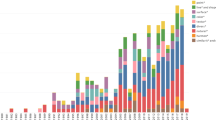Abstract
A previous study proposed a new model for generating random spatial patterns for modelling the dispersion of different colors in an image (Chiarello et al., 1996). These simulations represented spatial structures in the sense of landscape ecology and they had to be compared to a real image. Thus, the aim of the present study was to measure the discrepancy between a set of simulations of multicolored mosaics and an observed pattern in order to build a Monte Carlo test. The multicolored mosaics were considered as random closed sets and described with the hitting function for all pairs of colors. This description provided large three-dimensional data tables (distances × color pairs × images) that were analyzed with the help of multiway data analyses. The partial triadic analysis was used. It provided a synthesis of the hitting function since the intrastructure enabled a typology of the distances for each image: the factorial coordinates of supplementary columns were plotted as ordinates against distances as abscissa. This synthetic descriptor provided a graphic tool for measuring the differences between the spatial dispersions of a same set of colors in several images.
Similar content being viewed by others
References
N. Ahuja and B.J. Schachter, Pattern Models, Wiley: New York, 1983, p. 309.
W.L. Baker, “A review of models of landscape change,” Landscape Ecology, Vol. 2, pp. 111–133, 1989.
J.P. Bravard, C. Amoros, and G. Pautou, “Impact of civil engineering works on the successions of communities in a fluvial system,” Oikos, Vol. 47, pp. 92–111, 1986.
P.A. Burrough, Principles of Geographical Information Systems for Land Resource Assessment, Clarendon Press: Oxford, 1986.
E. Chiarello, C. Amoros, G. Pautou, and J.M. Jolion, “Landscapes modelling using the stochastic pyramid and analytical models of successions,” Ecological Modelling(submitted).
E. Chiarello, J.M. Jolion, and C. Amoros, “Model of spatial organization of vegetation in river floodplains,” Acta Stereologica, Vol. 12, No.2, pp. 255–261, 1993.
E. Chiarello, J.M. Jolion, and C. Amoros, “Regions growing with the stochastic pyramid: Application in landscape ecology,” Pattern Recognition, Vol. 29, No.1, pp. 61–75, 1996.
N.A.C. Cressie, Statistics for Spatial Data, Wiley & Sons: New York, 1991, p. 900.
P.J. Diggle, “Binary mosaics and the spatial patterns of heather,” Biometrics, Vol. 37, pp. 531–539, 1981.
P.J. Diggle, Statistical Analysis of Spatial Point Patterns, Academic Press: London, 1983, p. 148.
S. Dolédec and D. Chessel, “Recent developments in linear ordination methods for environmental sciences,” Advances in Ecology, Vol. 1, pp. 133–155, 1991.
F. Glaçon, “Analyse conjointe de plusieurs matrices de données. Comparaison de différentes méthodes,” Thèse de 3° cycle, Scientific and Medicale University of Grenoble, p. 73, 1981.
D.C. Glenn-Lewin and E. van der Maarel, “Patterns and processes of vegetation dynamics,” in Plant Succession: Theory and Prediction, Glenn-Lewin et al. (Eds.), Chapman & Hall: London, 1992, pp. 11–59.
M.F. Goodchild, “Integrating GIS and remote sensing for vegetation analysis and modeling: methodological issues,” J. of Vegetation Sci., Vol. 5, No.5, pp. 615–626, 1994.
M.F. Goodchild, B.O. Parks, and L.T. Steyaert, Environmental Modeling with GIS, Oxford University Press: New York, 1993.
P.A. Jaffrenou, “Sur l'analyse des familles finies de variales vectorielles: bases algébriques et application à la description statistique,” Thèse de 3° cycle, C. Bernard Lyon I University, p. 97, 1978.
D. Jeulin, “Modèles morphologiques de structures aléatoires et de changements d'chelle,” Thèse d'Etat, Caen University, p. 261, 1991.
D. Jeulin, “Study of spatial distributions in multicomponent structures by images analysis,” Acta Stereologica, Vol. 5, No.2, pp. 233–239, 1986.
J.M. Jolion and A. Rosenfeld, A Pyramid Framework for Early Vision, Kluwer Academic Publishers: London, 1994, p. 218.
D.G. Kendall, “Foundations of a theory of random sets,” in Stochactic Geometry, E.F. Harding and D.G. Kendamm (Eds.), Wiley: New York, 1974, pp. 322–376.
P. Kroonenberg, Three-Mode Principal Component Analysis, DSWO Press, 1983, p. 398.
G. Matheron, “Random sets theory and its application to stereology,” Journal of Microscopy, Vol. 95, pp. 15–23, 1971.
G. Matheron, Random Sets and Integral Geometry, Wiley: New York, 1975.
P. Meer and S. Connelly, “A fast parallel method for synthesis of random patterns,” Pattern Recognition, Vol. 22, pp. 189–204, 1989.
G. Pautou, J. Girel, B. Lachet, and G. Aïn, “Recherches écologiques dans la vallée du Haut-Rhône français,” Documents de Cartographie Ecologique, Vol. 22, pp. 5–63, 2 appended maps, 1979.
B.D. Ripley, Spatial Statistics, Wiley: New York, 1981, p. 252.
B.D. Ripley, Statistical Inference for Spatial Processes, Cambridge University Press: Cambridge, 1988, p. 148.
J. Serra, Image Analysis and Mathematical Morphology, Academic Press: London, 1982, p. 610.
D. Stoyan and J. Ohser, “Correlation between planar random structures (with an ecological example),” Biometrical J., Vol. 24, pp. 631–747, 1982.
J. Thioulouse and D. Chessel, “Les analyses multitableaux en écologie factorielle. I: De la typologie d'état à la typologie de fonctionnement par l'analyse triadique,” Acta Oecologica, Oecologica General, Vol. 8, No.4, pp. 463–480, 1987.
L.R. Tucker, “Implications of factor analysis of three-way matrices for measurement of change,” in Problems in Measuring Change, C.W. Harris (Ed.), University of Wisconsin Press: Madison, 1963, pp. 122–137.
Author information
Authors and Affiliations
Rights and permissions
About this article
Cite this article
Chiarello, E., Chassery, JM. Typology of Spatial Structures of Images having the Same Color Set. Journal of Mathematical Imaging and Vision 7, 359–374 (1997). https://doi.org/10.1023/A:1008211329008
Issue Date:
DOI: https://doi.org/10.1023/A:1008211329008




